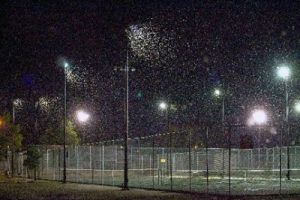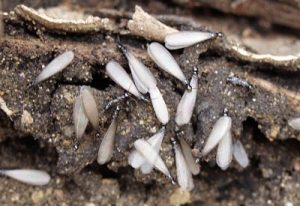
You wake up one summer morning and you see that seemingly millions of flying insects are up in the air, forming a giant cloud.
The picture is rather overwhelming.
But should you be afraid of the termite swarm? Can it harm your house? What is a swarm and when does it happens?
Let me tell you all about this.
Hide content
- What is a swarm?
- Photo
- Is the swarm dangerous?
- What if the swarm started inside the house?
- What if the swarm started in your garden?
- How the swarm can be useful?
- How to prevent the swarm?
- Useful articles
- Helpful video
What is a swarm?
The colony of termites has its rules. In each termite nest there are three casts:
The reproductives are:
- Queen.
- King.
- Alates (winged termites).
The alates are the ones you see when you watch the swarm. As the name implies, these reproductives primary goal is to reproduce by forming another colony. So all these flying reproductives are potentially new kings and queens of the new nests.
Normally the swarm occurs quite suddenly on a wet early summer morning or on a warmish spring day. All the winged termites leave the nest at once, each in search for perfect place for the new colony and a partner to mate with.
There are thousands of termites emerging from the hollow wood or from under the ground. You can imagine these insects ruling the world by now if even one quarter of the alates would make the new nests on their landing.But luckily for us there are plenty of animals and insects interested in feeding on the swarming termites. So, half of the reproductives are usually eaten by thriving birds, reptiles or even just ants finding helpless alates on the ground.
Some will not find their mates, others no perfect place for the nest and so for the rest of the swarm. Only very few survive and find proper conditions to fulfill their mission.
For the perfect colony different types of termites need different specific requirements. The drywood termite needs just a piece of wood, the softer the better.
Learn more about drywood termites: signs of their activity; best methods of treatment: spot treatment and DIY methods; how to get rid of them in furniture?
Dampwood termite will search for the rotting log and subterranean has to have good source of moisture and soil. Once a couple of future royals find the perfect spot, they start the new colony, which will have its own swarmers only after 3-5 years when fully grown.
Learn more about subterranean termites: signs of their activity; best methods of treatment and DIY methods. Eastern subterranean termites and their tunnels and tubes with photo.
Photo
On the pictures below you can see how termites swarm in house:
Is the swarm dangerous?
Can termites fly around your house? Definetely yes, but are they dangerous for human? On its own the swarm can do no harm.
Of course it’s not pleasant if you’ve been caught in the middle of it or it started right in your house, but that’s as much harm as there is.
It’s the worker termites that being primary foragers in the colony, destroy the wood to feed the other members with cellulose.
If you see flying termites outside of the house it a definitive sign of:
- Termite infestation in progress.
- High risk of termite infestation.
As you can see termites flying around house is not a good sign, but there is no serious danger for human health.
What if the swarm started inside the house?
Well, if there are termite swarmers in house it is not good. Basically it means that you have a fully grown drywood termites’ colony nesting in your timber or furniture. So first of all pay attention and maybe you’ll catch a glimpse of where exactly the alates are coming from.This will let you know precisely where the nest is situated. Otherwise you can try to inspect the house yourself:
- Take a screwdriver and knock with the blunt side on every wooden piece you can think of in your home. Once you’ve found the hollow wood you’ve found your enemy. But don’t stop before you check everywhere. It might be more than one colony around.
- Look around the window and door sills for the frass. It looks a lot like sawdust. So if you find something resembling it and there isn’t any reason for the sawdust to be there, you might be looking at a frass.
Drywood are slightly easier to get rid of than the subterranean termites. Sometimes it’s enough just to burn the piece of wood where the nest has been found.
But my strong recommendation in case if termites swarming inside house is to get in touch with your local pest control service, they might see something you’ve skipped in your unprofessional inspection and help you prevent the re-infestation.
Here you can learn more information about effective treatment method called tenting (fumigation): dangers for termites, preparing for fumigation and cleaning after, how long does this procedure last?
Many people are mistaken when thinking that they can find swarming termites in the house only, you can find pests outside of the house too. This situation will be desribed by us in the section below.
What if the swarm started in your garden?
In the best case scenario, you have the colony of subterranean termites very close to your building.
And it’s fully grown. Not to scare you, but if you’re facing Formosan termite it might be that it’s the size of several millions of individuals.
And the chances that one day they will not get into your house, if not properly protected are small.
Worst case scenario – your property has already been infested.
In any case, call your pest control office. The soil treatment and chemical baits are the methods that should be used by licensed professionals.
Important! One technique you can try to use yourself is the use of the beneficial nematodes. These are tiny worm larvae that feed on termites and being delivered to the nest and can destroy the colony from the inside.To sum up, if you observe swarming termites outside of the house call the professionals immediately, in order to avoid serious infestation inside the building.
How the swarm can be useful?
You will be surprised but termites with wings in house can be useful too and in this section we will be speaking about it.
First of all, the place where the swarm is emerging from might clearly indicate the location of the termite colony and generally the presence of one. Sometimes you might have skipped the swarming time itself, but you still have a chance to notice some signs that can tell you all about it.
The thing is like many flying insects, the winged termites are attracted by the light. So they usually come close to the doors and windows of the buildings.
Around these areas you can find later some dead alates or just some shed wings. Any of these signs tells you that the swarm happened. It also should be mentiones, that you can find termite alates in house too.
Secondly, the termite reproductives are the colony members that are the best for the identification of the termite species. And knowing who exactly your enemy is can be very important for choosing relevant methods of fighting the infestation.
The best course of action will be to keep the shed wings or alates found in the house just where they are and call for the pest control inspection.
The location of the wings and size of the termites can give professional exterminators some information about the colony.
Otherwise you can collect the parts of winged termites in house in a plastic zip bag and bring it for the identification to the office.
If you’re not a big entomology geek don’t try to identify flying termites inside house by yourself – it’s not that easy and requires some good magnifying equipment.
One thing you can see by yourself is that the insects you’ve found are in fact termites and not ants.
There are three main differences:
- Body shape.
- Wings.
- Antennae.
Ant will have two pairs of wings different in size and shape, elbowed antennas and the body will be classic ant with the head, chest and thorax and a thin waist.
Termite wings will be all similar and almost twice longer than its body. It has straight antennas and the body that is not clearly divided into three parts.Obviously if you’re having an ants’ infestation, the treatment methods will be different.
How to prevent the swarm?
You cannot stop the termites from swarming or the swarm from leaving the nest. The only thing you can and have to do is to use the preventive measures against the infestation possibility.
So, what to do when termites swarm in your house? You can do some wood treatment yourself, using natural oils such as orange oil. Some types of baits can be installed without specialized help too.
In addition, if there are flying termites in house you can try to create some barriers via the soil treatment methods, but remember that for the best efficiency it has to be done before the house construction.
And the last thing is you should be careful that your plumping is in good shape, so that you don’t have any wet places in the house attracting subterranean termites.
And if you’re not really a DIY person, just make a contract with a reputable pest control operator in your region and let them be responsible for your house safety.
This will also prevent you from paying for the inspection each time you see a swarm nearby as they will be obliged to do it for free at least annually.
Useful articles
If you interested in more information of termites we recommend you to read the following articles:
- All types of termites. Are they harmful to humans? Can they bite you? And what is the difference between drywood and subterranean ones?
- What does swarmers of different species look like: drywood, subterranean, formosan?
- Signs of infestation outside and in the house: in walls or furniture.
- What does termite holes look like? What is droppings and is it toxic to humans? Do termites make noises?
- Posible termite damage, how does it look like? Examples of damage in walls and wood floors.
- All about flying termites: how do they look like, swarming season and what to do if there are swarmers in your house?
- How do they do nests and mounds? How to find it in your garden or inside the house?
- Termite life cycle – from egg to larvae.
Helpful video
In the video below you see how termite swarm outside house:







